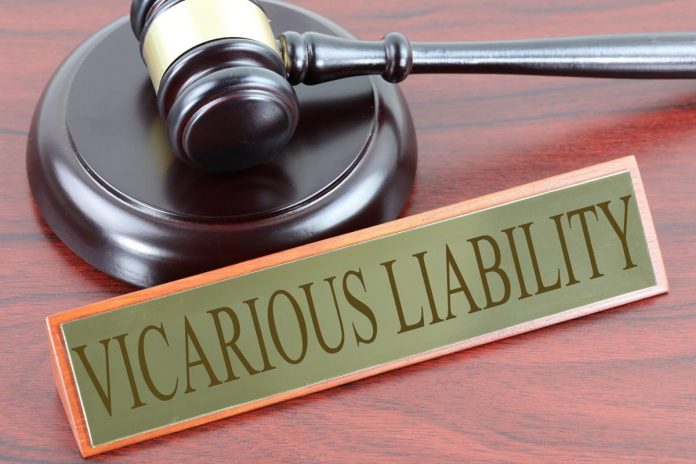This article is written by Adarsh Singh Thakur, student, Indore Institute of Law.
Introduction
Whenever a person commits an act which is unlawful, that person is held liable for violating the law and thus he is punished accordingly. For e.g. A enters into the property of B without his permission, such an act of A amounts to trespass and thus he is liable.
This is the general rule of torts but in some situations a person can be made liable even if he has not done any wrong, if it is done by some other person with whom he shares a certain relation, such as master and servant or principal and agent and in these cases his liability is called vicarious liability.
What is Vicarious Liability?
Vicarious liability means the liability of a person for an act committed by another person and such liability arises due to the nature of the relation between the two. For e.g. A, is a driver who works for B and while driving B’s car for taking him to his office, he hits C, a pedestrian due to his negligence in driving. In such a case even though B was not driving the car he will still be liable for the accident which was caused due to the negligence of A.
Relations in which Vicarious Liability arises
These are the major relations in which vicarious liability of a person arises
- Master and Servant.
- Partners in a Partnership Firm.
- Principal and Agent.
- Company and its Directors.
- Owner and Independent Contractor.
Vicarious Liability of Master for torts by Servant
In a Master-Servant relationship, the master employs the services of the servant and he works on the command of master and thus a special relation exists between the two and in case of a tort committed by the servant, his master is also held liable.
There are many cases in which the servant does an act for his master and thus in law, it is deemed that the master was doing that act himself, therefore if the servant commits an unlawful act the master will also be held liable for the same. This liability of the master is based on the following two maxims
1.Qui facit per alium facit per se: – It means that whenever a person gets something done by another person then the person is viewed to be doing such an act himself.
Illustration: If A is the owner of many trucks and employs drivers to drive them for the purpose of trade and in case one of his drivers gets into an accident because of his rash driving, then even though A did not drive the truck himself, he will be liable for the accident.
2. Respondant Superior: – It means that the superior should be held responsible for the acts done by his subordinate.
These two maxims have played a significant role in the development of the law of vicarious liability of the master.
Essentials of Vicarious liability in Master-Servant Relationship
These essential conditions have to be followed for the vicarious liability of master to arise: –
1. The servant has committed an act which amounts to a tort.
2. Such a tortious act is committed by the servant during the course of his employment under the master.
Reasons for liability of the Master
There are several reasons behind holding the master liable for the acts of his servants which are: –
- An act which is committed by the servant is considered to be done by the master through him and therefore in the law of torts, it is assumed that if any wrong is done by the servant, it has been committed by his master indirectly and so the master is held liable for these wrongs.
- The master is in a better financial position as compared to his servant and thus in case of any loss caused by the tortious act of the servant, the master is better suited to pay off the damages to the victim of the act. Also, since the master is made liable he makes sure that all reasonable care and precautions are carried so that he can avoid such liability.
- When a servant does any act, the benefit from such an act is enjoyed by the master and thus for the liability arising out of the servant’s act, the master should also shoulder that liability.
Test for Determining Master-Servant Relationship
For the determination of a Master-Servant relationship, certain tests have been developed over a long period of time.
Traditional View – Control Test
As per this test, for the determination of a master and servant relationship, it should be seen whether the master has the power to not only instruct what should be done but also the manner of doing the act and if such power exists then as per this test, the master and servant relationship exists between the two.
Illustration: A is the owner of a big area of land on which farming activities are carried out and he has hired many workers for farming. A, not only instructs them how to do their jobs but also how to do it. Here, by the test of control, the relation between A and his employees is established as that of a master-servant.
Modern View
The old Control test is not applicable as an exhaustive test because in cases of work requiring skill such as a doctor working in a hospital, the owner of the Hospital cannot instruct the doctor on how to treat a patient and can only instruct him to treat patients. Thus certain other tests have been developed for determining the Master and Servant Relationship.
The test of work being an Integral Part of Business
In the case of Stevenson Jordan & Harrison Ltd. V Macdonald & Evans (1952) 1 TLR 101, the test of an integral part of the business was applied. Here, a contract of service was held to be a contract for such work which is an integral part of the business and a contract for service was held to be a contract for such work which is not an integral part of the business.
Illustration: In an IT company the programmers are the employees of the company and there is a master-servant relationship but if the company has hired catering services, the company does not have a master-servant relationship because the act of providing food is not an integral part of an IT company.
Multiple Test
This test provides that people who are in a contract of service are deemed to be employees whereas the people who are in contract for service are independent contractors. In the case of Ready Mixed Concrete v Minister of Pensions and National Insurance (1968) 2 QB 497, three conditions were laid down for a contract of service
- The servant agrees to provide his skill and work to the master for performing some service in exchange for wages or some other consideration.
- He agrees to be subjected to such a degree of control so as to make the person his master in performance of his work.
- The other provisions of the contract are consistent with this provision of being a contract of service.
This view was also reiterated in the case of The Management of Indian Bank v. The Presiding Officer.
This test also includes other important factors that are used to determine the master-servant relationship such as who owns the tools being used for the work, is the employee paid wages monthly or on a daily basis and all other relevant factors.
Thus the old view of using Control test is no longer the only method of determining the relation of master and servant as it has been realized that in the present complex world where there are a wide number of factors which affect the process of determining the relation between the employee and the employer, it is not possible to use just one test and thus the various aspects of a case are seen to determine the nature of the relationship and to decide whether such a relation is that of master and servant or not.
Difference between Servant and Independent contractor
A servant and an independent contractor both do the work at the behest of another person and thus what shall be done is not decided by them but by some other person and thus on the face of it appears, that both are in the same category and a master should be liable for the torts committed by both of them but there is a difference between the two which separates them and consequently, while, in case of tort by servant, the master is liable but in case of independent contractor the master cannot be held liable.
In case of a servant there is a contract of service which means that along with instructing what task should be done by the servant, the master also has the right to instruct the manner in which that act has to be done and thus the servant does not have autonomy in the performance of his duties.
Illustration: P is the owner of a newspaper in which many editors are working. Here P as the owner has the right of telling them which news should be covered and how it should be written.
Whereas in the case of an independent contractor there is a contract for service which means that he can only be instructed as to what should be done but how to do the work is left at his will and he does not take any instructions from the master.
Illustration: If P is the owner of a newspaper and his machinery is damaged and he calls J to repair it. Here P can instruct him what to do but how to repair the machinery is left to be done by J without any instructions from P.
Various ways in which liability of Master arises
A master becomes liable in the following situations:
Wrong done as a natural consequence of an act by Servant for Master with due care
If the employee does an act which is done in pursuance of the instructions of the master, then the master will be held liable for any wrong which arises out of such an act even if all due care is taken by the employee in discharging his work.
In Gregory v. Piper(1829) 9 B & C 591, the defendant and plaintiff had some disputes between them and the defendant, therefore, ordered his servant to place rubbish across a pathway to prevent the plaintiff from proceeding on that way and the servant took all care to ensure that no part of it was touching the part of the plaintiff’s property but with the passage of some time. The rubbish slid down and touched the walls of the plaintiff and thus he sued for trespass. The defendant was held liable despite his servant taking all due care.
Wrong due to Negligence of Worker
A master is also liable for an act of servant which he does negligently or fails to take due care in carrying out.
In Pushpabai Purshottam Udeshi & Ors. v. Ranjit Ginning & Pressing Co. (P), deceased was travelling in a car driven by the manager of the respondent company and it met with an accident as a result of which he died. The dependents of the deceased filed a claim and the tribunal allowed damages but on appeal to the High Court, it was set aside on the grounds that the accident does not make the respondent company liable. But the Supreme Court in its judgement overruled the judgement of the High Court and held that from the facts of the case it was clear that the accident had occurred due to the negligence of the manager who was driving the vehicle in the course of his employment and therefore, the respondent company was liable for his negligent act.
Illustration: If H works as a house cleaner for K then there is a master and servant relationship between them but, if H instead of cleaning the house decides to cook food even though he has only been hired for cleaning the house and due to his negligence causes a fire which also causes loss to K’s neighbour L, then K, will not be liable because H did an act which was outside the course of his employment.
Wrong by excess or mistaken execution of a lawful authority
For making the master liable in such a case it has to be shown that: –
- The servant had intended to do an act on behalf of his master, which he was authorized to do.
- The act would have been lawful if it was done in those circumstances which the servant mistakenly believed were true or if the act would have been lawful if done properly.
In Bayley v Manchester S&L Railway (1873) LR 8 CP 148, a porter of a railway company while working mistakenly believed that the plaintiff was in the wrong carriage even though he was in the right one. The porter thus pulled the plaintiff as a result of which the plaintiff sustained injuries. Here, the Court held the railway company vicariously liable for the act of the porter because it was done in the course of his employment and this act would have been proper if the plaintiff was indeed in the wrong carriage.
In Anita Bhandari & Ors. v. Union of India, The husband of the petitioner went to a bank and while entering inside it, the cash box of the bank was also being carried inside and as a result, the security guard in a haste shot him and caused his death. The petitioner had claimed that the bank was vicariously liable in the case because the security guard had done such act in the course of employment but the bank had contended that it had not authorized the guard to shoot. The Court held the bank liable as the act of giving him gun amounted to authorize him to shoot when he deemed it necessary and while the guard had acted overzealously in his duties but it was still done in the course of employment.
Wrong committed willfully by a servant with the intention of serving the purpose of the master
If a servant does any act willfully, recklessly or improperly then the master will be held liable for any wrong arising out of such act, if such an act is done in the course of employment.
In Limpus v. London General Omnibus Co. (1862) EngR 839, the driver of the defendant company, willfully and against the express orders not to get involved in racing or to obstruct other omnibuses, had driven to obstruct the omnibus of the plaintiff. In the case, the Court held that the defendant company was liable for the act of driver because the driver’s act of driving the omnibus was within the scope of the course of employment.
In Peterson v. Royal Oak Hotel Ltd. (1948) N.Z.I.R. 136, The plaintiff was a customer who on being intoxicated was refused further drinks by the barman, who was employed under the respondent and thus the plaintiff threw a glass at him. The barman took a piece of the glass and threw it at him which hit his eye. The respondent hotel was held liable due to the act of the barman who had a master-servant relation with them.
Wrong by Servant’s Fraudulent Act
A master can also be held liable for any fraudulent act of the servant.
In Lloyd v. Grace Smith & Co. (1912) A.C. 716, the plaintiff was a widow who owned 1000 pounds as dues on a mortgage and a cottage. She went to the manager of the defendant, which was a firm of solicitors, and she asked for his advice to get richer. The manager told her to sell her cottage and to call up the amount of mortgage. She authorized the manager to sell the property and to collect her money but he absconded with the money. Thus, she sued the defendant company. It was held that the defendant was liable for the fraudulent act of the manager because even a fraudulent act is not authorized, the manager was authorized to take her signature and thus it was within the course of employment.
Illustration: If A goes to a bank and deposits a check with C, an employee of the bank and C fraudulently transfers that amount to his wife’s account. Here for the fraudulent act of C, the bank will be liable.
Conclusion
Under Vicarious Liability a person can be held liable for the torts committed by another person if that person shares a Master-Servant relation with him. The servant does the act on behalf of his master and therefore the law of torts provides that any wrongful act which is done in the course of employment by the servant is bound to make the master liable for it. There have been several tests for determining the relation of master and servant and the Court also applies its discretion according to the facts of the case to determine such a relationship.
Students of Lawsikho courses regularly produce writing assignments and work on practical exercises as a part of their coursework and develop themselves in real-life practical skills.
LawSikho has created a telegram group for exchanging legal knowledge, referrals, and various opportunities. You can click on this link and join:
Follow us on Instagram and subscribe to our YouTube channel for more amazing legal content.
 Serato DJ Crack 2025Serato DJ PRO Crack
Serato DJ Crack 2025Serato DJ PRO Crack












 Allow notifications
Allow notifications



